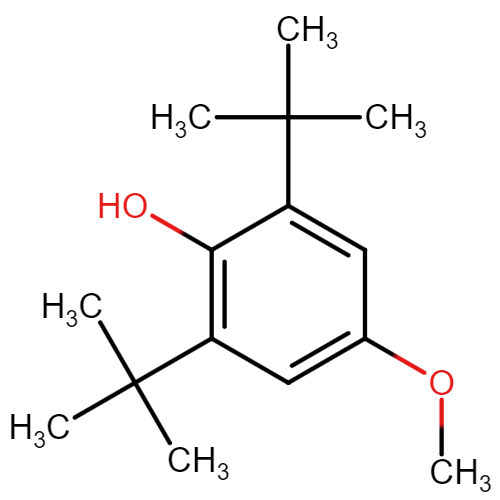3,5-di-tert-Butyl-4-hydroxyanisole
| Compound Structure: |

|
||||||||||||||||||||||||||||||||||||||
|---|---|---|---|---|---|---|---|---|---|---|---|---|---|---|---|---|---|---|---|---|---|---|---|---|---|---|---|---|---|---|---|---|---|---|---|---|---|---|---|
| Synonyms: | 2,6-DI-TERT-BUTYL-4-METHOXYPHENOL;489-01-0;3,5-Di-tert-butyl-4-hydroxyanisole;Topanol 354;2,6-ditert-butyl-4-methoxyphenol;3,5-di-t-Butyl-4-hydroxyanisole;Phenol, 2,6-bis(1,1-dimethylethyl)-4-methoxy- | ||||||||||||||||||||||||||||||||||||||
| Compound ID: | NMPC-319 | ||||||||||||||||||||||||||||||||||||||
| PubChem ID: | |||||||||||||||||||||||||||||||||||||||
| Molecular Formula: | C15H24O2 | ||||||||||||||||||||||||||||||||||||||
| Canonical SMILES: | CC(C)(C)C1=CC(=CC(=C1O)C(C)(C)C)OC | ||||||||||||||||||||||||||||||||||||||
| InChIKey: | SLUKQUGVTITNSY-UHFFFAOYSA-N | ||||||||||||||||||||||||||||||||||||||
| About the compound: | 2,6-di-tert-butyl-4-methoxyphenol, commonly known as BHT (Butylated Hydroxytoluene), is a chemical compound classified as a member of phenols and methoxybenzenes. Here are some key points about BHT: BHT has a molecular structure in which it consists of a benzene ring with a methoxy (CH3O-) group at position 4 and two tert-butyl (2-methyl-2-propan-2-yl) groups at positions 2 and 6. The presence of these tert-butyl groups contributes to its antioxidant properties. BHT is widely recognized and used as an antioxidant in various industries, including food preservation and the stabilization of certain products such as cosmetics and pharmaceuticals. Its antioxidant activity is due to its ability to inhibit or slow down the oxidation of substances, which can lead to the degradation of products. As a member of methoxybenzenes, BHT is part of a group of compounds that contain methoxy (-OCH3) substituents attached to a benzene ring. These compounds often have specific chemical and biological properties. While BHT is primarily known for its synthetic production and industrial uses, it has also been identified in nature. Your provided information mentions its natural occurrence in Betula platyphylla var. japonica, which is a species of birch tree. In this context, it suggests that BHT may be produced by certain plants for various reasons, possibly related to its antioxidant properties. BHT's role as an antioxidant makes it valuable in preserving the quality of various products, particularly those prone to oxidation. Its use in both industrial and natural contexts underscores its significance in maintaining product stability and preventing the detrimental effects of oxidation. GHS Hazard Statements • H315 (100%): Causes skin irritation [Warning Skin corrosion/irritation] • H319 (100%): Causes serious eye irritation [Warning Serious eye damage/eye irritation] • H335 (97.73%): May cause respiratory irritation [Warning Specific target organ toxicity, single exposure; Respiratory tract irritation] |
||||||||||||||||||||||||||||||||||||||
| Properties: |
Chemical
and Physical Properties
Source: PubChem |
||||||||||||||||||||||||||||||||||||||
| Source Species: |
Tragia benthamii |